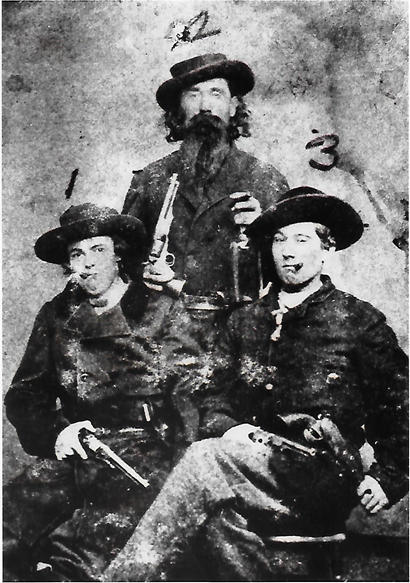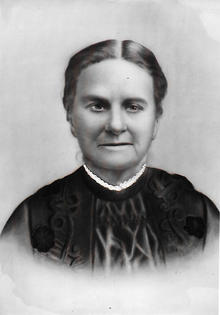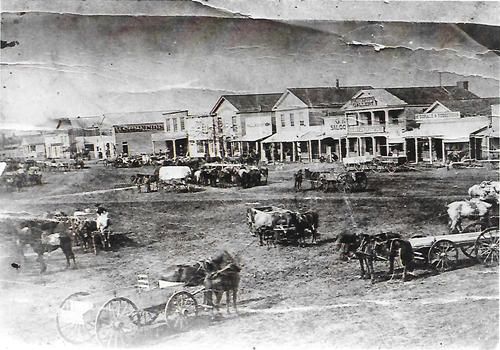|
|
Texas
| Columns
Quantrill's
Raiders in Texas
The outlaws who tormented Sherman
by Evault Boswell |
The
burning band wagon lay smoldering behind them, along with the bodies
of the members of the band. The twelve-year-old drummer had crawled
twelve feet from the fire before he died.
The attack on Fort Blair had been a failure but the unexpected return
of General Blunt and his command gave the raiders the opportunity
take revenge on the Yankees for the death of their women. They killed
seventy-two of Brunt's soldiers along with band members.
Blunt was perhaps the Union general the raiders hated the most. Blunt
had arrived in a buggy, along with a lady and a bottle of brandy and
had mistaken Quantrill's men, who were wearing Federal uniforms and
flying an American flag, for a welcoming party from the fort and called
for a horse that he might ride to meet them.
But as he approached them he realized the line was ragged and the
officers were moving in an unmilitary manner. He spurred his horse
and escaped the carnage.
Bill Anderson wanted to attack the fort but Quantrill refused to do
so, considering Blunt and his men out in the open a more desirable
target. It was the beginning of a devision between Anderson and Quantrill
that would result in the disbanding of the gang when they got to Texas.
Quantill and his band of killers had left behind them in Missouri
the smoking buildings of Leavenworth, Kansas, along the bodies of
boys and men they had killed. Quantrill had been able to stir the
men into a fury because of the death and injury of their women in
the jail in Kansas City. Anderson, not yet Bloody Bill, had lost one
sister and another was injured. |
 |
 |
The raid had
been simply a revenge for Quantrill, who had been kicked out of the
city before the war. But the Yankees would soon get their own revenge
as Order no. 11 was put in place and the homes of the families and
supporters along the Kansas/Missouri line were burned and the occupants
expelled from the area.
With their support system destroyed as the landscape of southwestern
Missouri turned to burnt homes with only the blackened stones of the
chimneys still standing, Quantrill decided it was time to go south
to Texas.
After the battle at Baxter springs the motley group made a brief stay
at the camp of General Douglas H. Cooper, the only Indian General
in the confederate army, the raiders crossed the Red River at Colbert's
Ferry and settled into a camp on Mineral Creek, about fifteen miles
from Sherman,
Texas.
At first the citizens of Sherman
accepted the un-kept Missourians and in some cases, uncivilized killers
with open arms. They seemed to have a lot of money and they were spending
it in the saloon although the stores soon began to complain about
thefts and robberies.
They had their horse races down the main street of Sherman
and Quantrill practiced his deftness with a pistol by shooting the
bell in the steeple of the Methodist Church.
Quantrill's leaders had very little concern for the Southern cause,
but had become bushwhackers. Some, such as Bill Anderson, had concocted
a story about his father and uncle being hanged as Southern sympathizers
to give credibility among the others in Quantrill's quasi army who
had suffered genuine persecution by Union men.
Quantrill had also made up a story to make himself acceptable to the
other outlaws. His claim was that on a trip to Utah, he and his brother
were attacked by abolitionists who killed his brother and left him
for dead. He claimed he had been nursed back to health by an old Indian.
When his mother visited Kansas City after the war and was told the
story, she revealed that Quantrill had no brother.
Anderson, unlike some of the raiders, fared well in Texas as he found
a bride at the Iron Post Saloon and Grocery Store by the dubious name
of Bush Smith. Before he left Texas he bought her a house at 314 Cherry
Street in Sherman
and when he was killed in Missouri at Centralia, he left behind not
only Bush, but a baby girl named Jimmye that he never saw.
John McCorkle in his book, "Three Years with Quantrill" claimed to
be Quantrill's colonel but in reality he was a scout. He was captured
while fighting with the Missouri State Guard under the leadership
of Sterling Price. He took the oath not to fight against the North
but reneged and joined Quantrill as a bushwhacker.
Sophia Butts, the leader of society in northeast Texas welcomed Quantrill
to the parties at Glen Eden, her spacious home, where he was known
as a "son of a prominent Missouri family."
The charm wore thin as the drunken raiders proved they were something
less than gentlemen even by General Henry McCulloch, commander of
the Confederate forces in North
Texas.
On February of 1864 he wrote his commanding officer, General J. B.
Magruder:
Quantrill will not obey orders, and so much mischief if charged
to his command here that I have determined to disarm, arrest, and
sent his entire command to you or General Smith.
General Kirby Smith, stationed in Shreveport, Louisiana, considered
Quantrill an asset to the Southern cause and ordered McCulloch to
use his men to eliminate the whiskey stills in the thickets of northeast
Texas.
His men got into a fight among themselves and ended up killing all
the moonshiners except one, who they took back to Mineral Creek, along
with his still. McCulloch tried to get Quantrill's men to bring in
the many southerners who had escaped to the thickets to avoid conscription
into the Southern Army but the raiders were not accustomed to taking
prisoners and killed more than they brought back for potential service.
McCulloch's letter continued:
They regard the life of a man less than you would that of a sheep-killing
dog.
The conflict between McCulloch and Quantrill's men came to a head
when one of them, Fletcher Taylor, killed Sophia Butt's husband. He
had gone into Sherman on business and did not return. His body and
emaciated horse were found. Taylor was seen later wearing his watch.
During a wide drunken Christmas celebration, one of Quantill's men
shot the tassel from Sophia's hat as she sat in the lobby of Ben Christian's
hotel in Sherman.
|
 |
 |
|
By spring, the
split between Anderson and Quantrill which had begun at Baxter Springs
had grown to a hatred that led to the dethroning of Quantrill as
the leader. His command began falling apart with the departure of
Cole Younger, perhaps because of his differences with Quantrill,
or his concern that he might be the father of Myra Mabelle (aka)
Belle
Starr's baby.
Anderson and Taylor went to Bonham
and told General McCulloch that Taylor had, indeed, shot Major Butts,
but he had done so on the orders of Quantill.
General McCulloch sent word for Quantrill to report to his headquarters
in Bonham and when the
bandit arrived at the general's hotel room, he was placed under
arrest and ordered to put his pistols on the bed.
After Quantrill cursed the general, McCulloch invited him to have
dinner with him in the hotel restaurant. Quantrill cursed him again
and McCulloch left the room, leaving two soldiers to guard the prisoner.
Quantrill, on the pretense of getting a drink of water, grabbed
his pistols that were still laying on the bed. He disarmed the guards
and escaped. Two more guards at the bottom of the stairs was disarmed
and Quantrill mounted his horse and yelled at the sixty men still
faithful to him who were across the street that it was a trap. They
rode out of Bonham in the
direction of the Red River.
When McCulloch got word of the escape, which had interrupted his
dinner, he sent Colonel J. Martin's regiment in pursuit. Martin's
command was the Fifth Texas Partisan Rangers. The crack in the guerrilla's
unity now became a chasm as Bill Anderson and his men joined Martin
in the chase.
A brief but heated battle took place at a little creek near Bonham
and Sherman.
Leslie, in "The Devil Knows How to Ride" reports that the fight
occurred at Bodark Creek, but there are two problems with that assumption.
First, the name of the creek and the tree in Texas is spelled bois
d'arc, a reminder that some of the early explorers of the territory
had been French.
The word, Bodark, appears in the letters of W. L. Potter, one of
Quantrill's men. The only problem is, no matter how you spell it,
the creek is on the east and south sides of Bonham
and from there it runs in a western direction. It hardly seems possible
that Quantrill crossed the creek when his only means of escape was
to reach the Red River and Indian Territory.
In Connelly's "Quantrill and the Border Wars, Potter is quoted as
saying: "I think it was Bodark Creek, if not, it was Caney Creek."
Caney Creek is on the west side of Bonham.
Bill Anderson led the guerrillas in pursuit of their formal leader,
joining colonel Martin. It had to be the most unusual battle of
the war with regular troops and guerrillas chasing Quantrill and
his men. It became even more strange as George Todd came from Mineral
Creek and joined in the combat with his old friend, Bill Anderson.
The battle at Caney Creek was brief and only one man wounded among
the raiders but the outcome was the end of Quantrill's command,
which now split into those faithful to Anderson, and those who decided
to ride with Todd.
Quantrill reached the Red River and crossed over, taking a position
of defense on the north bank. Colonel Martin arrived and under a
flag of truce, met Quantrill in the middle of the river, who refused
to surrender.
Martin took one look at the guns bristling from the north side of
the river and decided that his jurisdiction ended on the south side
of the river. The guerrillas chasing their old leader also halted
at the river except two of them crossed the river after dark and
tried to steal Quantrill's horse, old Charley. But Quantrill was
the only one who could ride the horse and they abandoned the attempt.
Quantrill rode north to join his child bride, Kate, in the Sni Hills
and except was idle except for an ill-fated trip to Kentucky. Some
say he was on his way to Washington to kill Abraham Lincoln but
news was received that Edwin Booth has already assassinated the
president.
Hounded by Federal and southern guerrillas, Quantrill was shot at
Payne' farm south of Louisville, Kentucky and paralyzed by the bullet
that entered his spine. He died in a Catholic Monastery after embracing
the faith.
Bloody Bill Anderson was gunned down at Centralia, Missouri when
Federal Troops used a bushwhacker trick themselves. The Federal
troops found Anderson camp and sent riders close enough to be seen.
When the raiders mounted their horses to chase them, they led them
into an ambush. Anderson rode through the line of Federals but was
shot in the back.
George Todd was killed in an action near Independence, Missouri
when he rode over a rise in the land and was hit by a bullet in
the neck and he suffocated in his own blood.
|
 |
 |
| Click on image
to enlarge |
And so it was
that the outlaws who had tormented the citizens of Sherman
came to a violent ends.
But if you go to Sherman,
Texas today and stand on the square who might still hear an echo
of the bold bandits laughter as they get drunk at the Iron Post Grocery
or you might hear a faint rumbling of Old Charley's hooves and they
pound down the street. You might even think you hear the bell on the
Methodist Church ringing as another bullet hits it.
But listen carefully and you will hear the Rebel yell, faint and distance
now, coming from the throats of the raiders as they ride through,
their reins in their mouths and two Navy Colts firing wildly in the
air.
8-23-17 Guest Column
© Evault Boswell |
|
|
